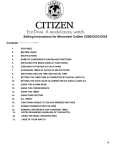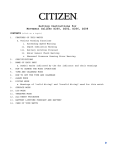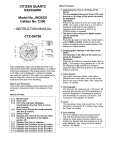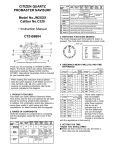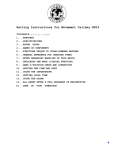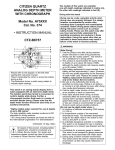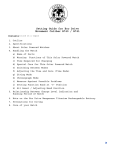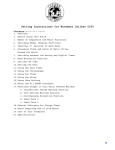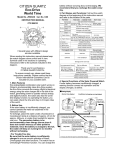Download Citizen Perpetual Calendar BL5334-55E Instruction manual
Transcript
CITIZEN QUARTZ Perpetual Calendar 2.Setting the Time and Calendar When the crown is of the screw lock type, turn it after loosening the screw. After the time, push and turn the crown clockwise and securely fasten the screw. Model No. BL0XXXX Cal. No. E71X • INSTRUCTION MANUAL CTZ-B8025 This is a Solar-Powered Watch: Sufficiently Recharge by Placing in Light Before Use A secondary battery is used in this watch to store electrical energy. This secondary battery is a clean energy battery that does not contain mercury or other toxic substances. Once fully charged, the watch will continue to run for about 10 months (at the time of power save) without additional charging. *Power Save: When light is not supplied to the solar cell and power generation stops, only the hour and minute hands work, leaving the second hand stops at 12 o’clock, to set in the power save state. When light is supplied to the solar cell and power generation resumes, the second hand moves quickly to catch up to the current second and then returns to the normal one-second movement. <How to Use This Solar-Powered Watch Properly> To use this watch comfortably, make sure to recharge the watch before it stops running completely. Since there is no risk of overcharging (Overcharging Prevention Feature), it is recommended that the watch be recharged everyday. 1. Feature This is an analog-powered watch that is equipped with a solar cell incorporated in its face to convert solar energy into electricity. It provides an auto dating perpetual calendar (year/ month/day, including the leap year with February 29) and a time difference correction feature to allow ease of adjustment without stopping the watch. Setting the Time 1. Pull the crown twice to the time correction position, and then the second hand advances rapidly to the zero-second position and stops. (Note 1) If the crown is pulled twice while the data is changing, the second hand advances rapidly to the zero-second position after the date change. (Note 2) If the second hand does not stop at the zero-second position, do all reset and then adjust the base position. 2. Set the time by click-turning the crown 嘷 1 A click to the right, the hour and minute hands move forward. 嘷 2 A click to the left, the hour and minute hands move backward. • When the crown is moved quickly (two or more clicks at a time), the hour and minute hands advance rapidly. Click the crown through one turn in either direction to stop rapid movement. (Note 1) When the hour and minute hands reach 12.00am, the date changes. (Hour and minute hands wait at 12.00am while the date is changing, and resume operation after the date change.) (Note 2) In the case of reversing, the date does not change, even when the hour and minute hands pass 12.00 am. 3. Set the time by a time signal and then return the crown to the normal position. Setting the Calendar • The calendar is of the perpetual type that automatically changes year/month/day including the leap year, once it is set. 1. Pull the crown once to the calendar correction position, and then the second hand moves to a year/month position it memorises and stops. (Note) If the crown is pulled once while the date is changing, the second hand advances rapidly after the date change. 2. Set the date by turning the crown: 嘷 1 A click to the right, the second hand moves one step. Turn the crown and set the second hand to a corresponding year/month position (years passed from the leap year). (Example) December of the leap year: Set the second hand to the zero position. April of a year 3 years after the leap year: Set the second hand to the 23 second position (between 4:00 and 5:00). 嘷 2 A click to the left, the date moves one day forward. • When the crown is moved quickly, the date advances continuously till it stops automatically after moving 31 days forward. Click the crown through one turn in either direction to stop continuous advancement in the middle. 3. After setting the calendar, securely return the crown to the normal position. The second hand catches up with the current second and resumes position. <When the Date is Set to a Non-existing Day> Returning the crown from the calendar correction position to the normal position automatically moves the date to the 1st day of the following month. (Example) • Normal year: February 29, 30, 31 – March 1 September 31 – October 1 • Leap year: February 30, 31 – March 1 September 31 – October 1 <How to Read the Month and Year> 䡲 Reading the Year • Leap year: The starting scale of each month zone 䡲 • 1st year from the leap year: 1st scale of each month 䡲 • 2nd year from the leap year: 2nd scale of each month 䡲 • 3rd year from the leap year: 3rd scale of each month 䡲 Reading the Month January: Between 1:00 and February: Between 1:00 and : : December: Between 1:00 and 2:00 2:00 : : 2:00 How to Adjust a Time Difference • Press button 嘷 A and click the crown quickly; the time difference can be adjusted in hours. Correction of time difference can be done during 30 seconds after pressing button 嘷 A or during 30 seconds after the last clicking of crown. 1. Return the crown to the normal position 2. Press button 嘷 A. 3. Adjust the time difference by clicking the right or left. • Quickly turning the crown to the right moves the hour and minute hands one hour forward (clockwise). • Quickly turning the crown to the left moves the hour and minute hands one hour backward (counter clockwise). • (Note 1) Two or more clicks at a time, if done, cannot make a rapid advancement. Be sure to do adjustment hour by hour. • (Note 2) When the hour and minute hands pass 0:00 a.m. the date is adjusted by the day after moving the hands. When adjusting a time difference, beware of a.m. and p.m. • (Note 3) To cancel the adjusted time difference, operate the hour and minute hands reversely. (When the hour and minute pass 0:00 a.m., the date is adjusted by one day after completion of the interval movement. The date must move forward (clockwise) through 30 days, so date adjustment will take 2-3 minutes.) (Example) Adjusting from Tokyo home time 10:10 a.m. to London local time: The time difference is 9 hours; when it is 10:10 a.m. in Tokyo, the local time in London is 1:10 a.m. To adjust the time difference; 1. Press button 嘷 A. 2. Click the crown left and reverse the hands 9 hours (counter clockwise) and set them to 1:10 a.m. (Note) If you click the crown to the right and move the hand clockwise to 1:10, the set time will become 1:10 p.m., confusing the changeover time of the calendar. The calendar will then fail to change the date at the correct time. Adjusting a 9-hour Time Difference <Years Passed from the Leap Year> Year Passage 2000 Leap year 2001 1st year 2002 2nd year 2003 3rd year Year Passage 2004 Leap year 2005 1st year 2006 2nd year 2007 3rd year *When the second hand begins 2-second interval movement urging recharging, time difference adjustment is not possible. Supply light to the solar cell and recharge power, waiting for time difference adjustment till the normal 1-second interval movement is returned. [Reference: Time Difference of Major Cities of the World Based on the Greenwich International Standard Time (UTC)] Time Summer Difference Time London Ⳳ0 䡬 Name of City Time Summer Difference Time Noumea +11 ⴒ Name of City Paris +1 䡬 Auckland +12 䡬 Cairo +2 䡬 Honolulu -10 ⴒ Moscow +3 䡬 Anchorage -9 䡬 Dubai +4 ⴒ Los Angeles -8 䡬 Karachi +5 ⴒ Denver -7 䡬 Dacca +6 ⴒ Chicago -6 䡬 Bangkok +7 ⴒ New York -5 䡬 Hong Kong +8 ⴒ Caracas -4 ⴒ Tokyo +9 ⴒ Rio de Janeiro -3 䡬 Sydney +10 䡬 * Cities (areas) adopting summer time are given circles and those not are given crosses. * The time difference and summer time of each country may be changed by the country. 3.Special Functions of Solar-Powered Watches <Note 1> If Time adjustment is omitted, the 2-second hitch movement continues. Further, if calendar setting is omitted subsequent to time adjustment, the second hand begins 5-second interval movement (Calendar Setting Warning Feature). <Note 2> When the watch is sufficiently recharged in the 2second hitch movement (Time Setting Warning), and afterwards recharging becomes insufficient without the time setting, it changes into 2-second interval movement (recharging warning). When the 2-second hitch movement begins, time adjustment should be made earlier and use it after it is sufficiently recharged. <Insufficient Recharging Warning Feature> The second hand changes to 2-second interval movement to inform the wearer of insufficient recharging. Although the watch will keep the correct time when this happens, the watch will stop when 2-second interval movement continues for about 2 days. Place the watch in light to recharge. The watch will return to 1-second interval movement. <Time Setting Warning Feature> Watch hands begin to move when light is supplied and insufficient charging is solved, but since the time is incorrect, the second hand tells by 2-second hitch movement that the time as well as the calendar is out of order. After thoroughly recharging, adjust the time and calendar. (Note) • If time adjustment is omitted, the 2-second hitch movement continues. • If the crown is returned to the normal position after adjusting the time only, the calendar setting warning feature is activated. <Calendar Setting Warning Feature> If the crown is returned to the normal position after adjusting the time only, omitting calendar adjustment, the second interval movement, telling the calendar is left unadjusted. Pull the crown once and adjust the calendar. (Readjust the calendar even if it is correct. It is recommended to click the crown right to adjust the month and year.) <Overcharging Prevention Feature> This enables the wearer to recharge without risk of damage to the watch. When the secondary battery is fully charged, the overcharging prevention feature is activated to prevent further recharging. <Power Save Feature> * When light is not supplied to the solar cell and power generation stops, the second hand stops at the zero second position, to set in the power save state. Although the second hand is stopped, the hour and minute hands continue to move correctly and the calendar is adjusted linked with the hour and minute hands. * Power save under normal hands movement The second hand stops at the zero second position, and when power generation begins, the second advances rapidly to catch up with the current second and then resumes the normal 1second interval movement. * Power save under recharging warning (2-second interval movement) The second hand stops at the zero second position, and when power generation begins, the second advances rapidly to catch up with the current second and then resumes the 2-second interval movement. * Power save under time setting warning (2-second hitch movement) The second hand stops at the zero second position, and when power generation begins, the second advances rapidly to catch up with the current second and then resumes the 2-second hitch movement. * Power save under calendar setting warning (5-second interval movement) The second hand stops at the zero second position, and when power generation begins, the second advances rapidly to catch up with the current second and then resumes the 5-second interval movement. (Note) When the secondary battery is fully charged and overcharging prevention is activated, the power save does not even work even when light is not supplied to the solar cell and power generation is not done. Likewise, the power save feature does not work either when the solar cell is fully charged temporarily by a sudden supply of intense light. 4. Charging Times The time required for charging varies according to the model of watch (colour of the watch face, etc.). The following table provides a general reference for determining charging times. * The charging time is continuous irradiation time. Charging Time Illuminance (lx) After stopping Environment For one day’s until one- use second interval For full charge movement 500 In ordinary office 2.5 hours 47 hours 13 days 1,000 60-70cm (24-28 in.) away from fluorescent desk lamp (30W) 50 minutes 19 hours 6 days 3,000 20cm (8 in.) away from florescent desk lamp (20W) 16 minutes 6.5 hours 39 hours 10,000 Outside, cloudy conditions 5 minutes 2.5 hours 11 hours 100,000 Outside, sunny conditions 1.5 minutes 55 minutes 3.5 hours Time required for full charge: Time from the state in which the watch has stopped until fully charged. Time required for one day’s use: Time required for the watch to run at 1-second intervals for one day. 5. Notes Regarding Handling of Solar-Powered Watches <Always Make Sure to Recharge Frequently> Please note that if you wear long sleeves, the watch may stop as a result of being covered by your sleeve and blocked from the light. * When you take off the watch, try to place it in as bright a location as possible.This will ensure that it will continue to run. • When not using the watch for a long period, we recommend storage under power save state to save power for a longer retention time. Recharging Precautions • The watch will be damaged during recharging if it becomes excessively hot (60⬚C/140⬚F). Avoid recharging when the watch is hot. Examples: Recharging when the watch is in close proximity to an incandescent lamp, halogen lamp or other light source that generates considerable heat, or recharging the watch while placed on the dashboard of an automobile or other locations subject to excessively high temperatures. • When you charge the watch by an incandescent lamp, take a distance about 50cm (20 in.) from the light source to prevent extremely high temperature. 6. Replacement of Secondary Battery Since the secondary battery used in this watch is able to be charged and discharged repeatedly, it does not have to be replaced periodically in the manner of ordinary batteries. 7. All Reset When affected by static electricity or hard shocks, watch indications may go wrong. In such a case, apply an all reset and the following base position adjustment. All reset is available from the state or insufficient recharging warning, time setting warning or power save. 1. Pull the crown twice (time setting position) • The second hand moves to a zero position it memorises and stops. 2. Press button 嘷 A 2 seconds or longer and release. • The hour and minute hands perform a demonstrative movement of “forwarding → reversing → forwarding.” 2. • The second hand makes a full forward turn. Now all reset is completed. Be sure to make base position adjustment after all resetting. If omitted, display positions of watch hands and date as well as the date changing time may go wrong. (Note 1) Do not apply all reset during date changing. Should dislocation occur, pull the crown once after all resetting, and with button 嘷 A pressed, turn the crown left and correct the date position. (Note 2) The demonstrative movement is not done when recharging is required. Recharge the solar cell thoroughly and then do all reset. 8. Base Position Adjustment After all resetting, adjust the hour and minute hands by pulling the crown twice and adjust the base position of date plate by pulling the crown once. 1. With the crown pulled twice, set the hour and minute hands to 12:00. 嘷 1 A click to the right, the hour and minute hands move forward. 嘷 2 A click to the left, the hour and minute hands move backward. • A quick right turn rapidly advances the hands right and a quick turn left rapidly advances them left. Click the crown through one turn in either direction to stop rapid advancement. 2. Pull the crown once and adjust the second hand to 00 second and the date plate to one day. 嘷 1 A click to the right, the second hand moves one second forward. 嘷 2 A click to the left, the date plate moves one day forward. • A quick left turn rapidly advances the date. The date stops automatically after moving through 31 days. Click the crown through one turn in either direction to stop rapid advancement. Indication 9. Precautions CAUTION Water-Resistance Performance There are several types of water-resistance watches, as shown in the following table. For correct use within the design limits of the watch, confirm the level of water-resistance of your watch, as indicated on the dial and the case, consult the table. * Water-resistance for daily use (to 3 atmospheres): This type of watch is water-resistant to minor exposure to water. For example, you may wear the watch while washing your face; however it is not designed for use underwater. • Upgraded water-resistance for daily use (to 5 atmospheres): This type of watch is water-resistant to moderate exposure to water. You may wear the watch while swimming, but it is not designed for use while skin diving. • Upgraded water-resistant for daily use (to 10/20 atmospheres): This type of watch may be used for skindiving; however it is not designed for scuba or saturated diving such as using helium gas. Examples of use moderate exposure to water Minor exposure to (washing, kitchen, water (washing work swimming, face, rain, etc.) etc.) Marine sports (skin diving) Scuba diving (with air tank) Saturation diving (helium enriched environment Operation of the crown with moisture visible NO NO NO NO NO OK OK NO NO NO NO OK OK OK NO NO NO Specifications Dial Case (Case back) WATER RESIST or no indication WATER RESIST(ANT) Water-resistant to 3 atmospheres OK WATER RESIST(ANT) 5 Water-resistant to 5 atmospheres bar or WATER RESIST(ANT) WATER RESIST(ANT) Water-resistant to WR 100/200 or 10/20 WATER RESIST 10 bar / 20 bar or atmospheres WATER 100/200 RESIST(ANT) WR 50 or WATER RESIST 50 3. Return the crown to the normal position and memorise the base positions of the hands and date plate. (Note 1) Memory recording of the standard position takes around one second. When it has been recorded, the second hand begins 2-second hitch movement. After you return the crown to its normal position do not pull the crown out until after 2-second hitch movement has started. 3. (Note 2) After all resetting, returning to the normal position by omitting crown clicking, right or left, at each of the 1st and 2nd pull positions does not memorise base positions, and thus the second hand is left stopped. 4. After adjusting the base positions, correctly adjust the time and calendar. • After setting the standard position, the time setting will change to 0:00 a.m. Set the time and calendar with reference to “2. Setting the Time and Calendar” to avoid confusing a.m. and p.m. * WATER RESIST(ANT) xx bar may also be indicated as W.R xx bar. CAUTION • Be sure to use the watch with the crown pressed in (normal position). If your watch has a screw-type crown, be sure to tighten the crown completely. • Do NOT operate the crown or button with wet fingers or when the watch is wet. Water may enter the watch and compromise the water-resistance. • If the watch is used in seawater, rinse with fresh water afterward and wipe with a dry cloth. • If moisture has entered the watch, or if the inside of the crystal is fogged up and does not become clear within a day, immediately take the watch to your dealer or Citizen Service Centre for repair. Leaving the watch in such a state will allow corrosion to form inside. • If seawater enters the watch, place the watch in a box or plastic bag and immediately take it in for repair. Otherwise, pressure will increase, and parts (crystal, buttons, etc.) may come off. CAUTION: Keep your watch clean. • Leaving dust and dirt deposited between the case and crown may result in difficulty in pulling the crown out. • Dust and dirt tend to be deposited in gaps in the back of the case or band. Deposited dust and dirt may cause corrosion and soil your clothing. Clean the watch occasionally. Cleaning the Watch • Use a soft cloth to wipe off dirt, perspiration and water from the case and crystal. • Use a soft, dry cloth to wipe perspiration and dirt from leather band. • To clean a metal, plastic, or rubber watch band, wash away dirt with mild soap and water. Use a soft brush to remove dust and dirt jammed in the gaps in the metal band. If your watch is not waterresistant, take it to your dealer. NOTE: Avoid using solvents (thinner, benzine, etc.), as they may mar the finish. CAUTION: Operating Environment • Use the watch within the operating-temperature range specified in the instruction manual. Using the watch where temperatures are outside the specified range, may result in deterioration of functions or even stoppage of the watch. • Do NOT use the watch in a place where it is exposed to high temperature, such as a sauna. Doing so may result in a skin burn. • Do NOT leave the watch in a place where it is exposed to high temperature, such as the glove compartment or dashboard of a car. Doing so may result in deterioration of the watch, such as deformation of plastic parts. • Do NOT place the watch close to a magnet. Timekeeping will become inaccurate if you place the watch close to a magnetic health equipment such as a magnetic necklace or a magnetic latch of a refrigerator door or handbag clasp or the earphone of a mobile phone. If this has occurred, move the watch away from the magnet and reset the time. • Do NOT place the watch close to household appliances that generate static electricity. Timekeeping may become inaccurate if the watch is exposed to strong static electricity, such as emitted from a TV screen. • Do NOT subject the watch to strong shocks such as dropping it onto a hard floor. • Avoid using the watch in an environment where it may be exposed to chemicals or corrosive gases. If solvents, such as thinner and benzine, or substances containing such solvents, come in contact with the watch, discolouration, melting, cracking, etc., may result. If the watch comes in contact with mercury used in thermometers, the case, band or other parts may become discoloured. 10. Specifications 1. Caliber No.: E71 2. Type: Analogue Solar-Powered Watch 3. Accuracy: Within Ⳳ15 seconds per month on average (When worn at normal temperatures of +5⬚C to +35⬚C/41⬚F to 95⬚F) 4. Operating Temperature Range: -10⬚C to +60⬚C/14⬚F to 140⬚F 5. Display functions: •Time: Hours, Minutes, Seconds • Calendar: Date display by date plate (with quick adjustment feature) Years passed and month display by second hand (Years passed and month are displayed only during calendar adjustment.) 6. Additional Functions: • Power Save Feature • Time Difference Correction Feature (forward and reverse adjustment in hours) • Insufficient Recharging Warning Feature • Time Setting Warning Feature • Calendar Setting Warning Feature • Overcharging Prevention Feature 7. Continuous Operating Time: • Fully charged to stopping: Approx 10 months (while in operation of power save feature) • 2-second interval movement to stopping: Approx 2 days 8. Battery Used: Secondary battery *Specifications are subject to change without notice. Water Resistance The water-resistant quality of our timepieces is offered in varying degrees depending on the model. This ranges from non-water resistant models to those suitable for SCUBA diving. Water resistance of our timepieces is measured in BAR or Barometric Pressure. Each BAR of pressure is equal to 14.5 pounds per square inch of pressure. Water resistance is measured when the watch is at a static, or motionless state. As the watch is moved in water, such as from the motion of swimming, pressure is added from velocity. While you may be swimming in a pool at surface level, the watch may be experiencing forces equal to that of 100 feet of water pressure (3 BAR). Diving into a pool can cause forces on the watch to exceed those pressures. As such, you should always allow a margin of safety when exposing your watch to moisture. Never "push the limit" of the degree of water resistance of your timepiece. A primary factor to keep in mind about water resistance is that periodic maintenance is needed to maintain original factory specifications for water resistance. When a watch is new, it meets specifications for water resistance as indicated on the case back. However, as the watch ages, the gaskets that seal the watch become dry and brittle, diminishing its water resistant quality. Exposure to environments such as chlorinated pools, salt water or soaps from showering can accelerate drying of the gaskets. We recommend that the gaskets be changed at least every 18 to 24 months to maintain the water resistant quality of your timepiece. If the watch is frequently exposed to chlorinated pools, soaps salt water, etc., we recommend that the gaskets be changed on a yearly basis. From time to time, you may notice condensation that appears then goes away after a short period of time. This is a normal occurrence and happens primarily from sudden temperature changes. When there are sudden temperature changes such as entering a cool building from the hot out of doors, or jumping into pool on a hot day the watch may fog. Conversely, if you go to the cold outdoors from a warm building, fogging may occur. As long as the fogging clears in a short period of time, there is no need for concern. Be sure the crown is completely pushed in prior to any contact with moisture. If your model is equipped with a screw down crown, be sure it is properly seated against the case. Do not operate the crown or any push button when the watch is wet as this may allow the entrance of moisture. . If at anytime, you notice moisture in your timepiece that does not clear in a short period of time, you should send your timepiece as soon as possible to the nearest Authorized Service Center for inspection. You can determine the level of water resistance of our watches from the markings on your case-back. Additionally, models that are water resistant to 100 or 200 meters have an indication on the dial as well. The case-backs and dials are normally marked as follows: The case back has no indication of water resistance This indicates the watch is a non water-resistant model and is not designed for contact with moisture at all. Caution should be exercised to avoid any contact with moisture, such as when washing your hands or from a rainstorm. “Water Resist” This watch is designed to withstand water from accidental splashing, such as from washing your hands or rain. Any submersion into water may result in the entrance of moisture. “Water Resist 10BAR” or “W.R. 10BAR”, Dial marked “WR100” This watch is designed to withstand water pressure up to 333 feet. This includes water exposure from accidental splashing and rain, but also from showering, swimming in a pool and snorkeling. Be sure to rinse the watch with fresh water after exposure to a chlorinated pool, salt water, soaps, etc. After rinsing with fresh water, be sure to dry the exterior with a soft cloth. “Water Resist 20BAR” or “W.R. 20BAR”, Dial marked “WR200” This watch is designed to withstand water pressure up to 666 feet. This includes all exposure to water up to and including recreational SCUBA diving. Be sure to rinse the watch with fresh water after exposure to a chlorinated pool, salt water, soaps, etc. After rinsing with fresh water, be sure to dry the exterior with a soft cloth. Special Note about Jacuzzis and Hot Tubs The various components used in the manufacture and assembly of your watch expand at various rates. This results in a loss of the sealing capabilities of gaskets, which may allow moisture to enter. In addition, heat from these sources can cause deformation of certain materials leading to mechanical failures. For these reasons, you should remove your watch before entering a hot tub or Jacuzzi.







